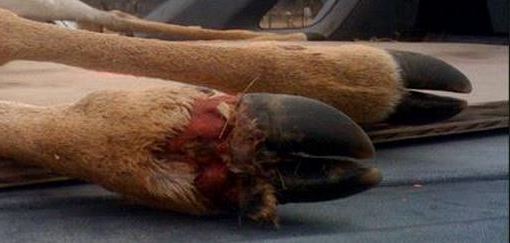It’s not uncommon to encounter white-tailed deer with swollen ankles or other hoof area injuries. A deer’s lower legs and hooves take a beating and are often cut and poked by sticks, fences and even other deer while fighting. Any open wound has the potential to become infected by a virus or bacteria — and disease can soon set in. Whitetail are incredibly tough animals, but they are susceptible to illness, especially when they are already in poor physical condition from situations such as overpopulation or poor habitat conditions.
Hoof Problems Due to EHD or Bluetongue
Epizootic Hemorrhagic disease, commonly referred to by its acronym, EHD, is an acute, infectious, often fatal, viral disease that affects whitetail, other deer and hoofed animals in general. In areas where EHD is commonly found, mortality rates are lower, usually less than 20 percent of the deer population. In areas where the EHD occurs only occasionally, the death toll from such outbreaks can be much higher on a percentage basis. Like many diseases, the mortality rate will increase with animal density.
The EHD in deer can be caused by epizootic hemorrhagic disease virus or the bluetongue virus. The outward signs of the diseases impact white-tailed deer in the same way, so it’s nearly impossible to identify the culprit with out clinical diagnosis. EHD and bluetongue disease are transmitted by biting midges. The virus does not survive long outside the insect or the deer host.
White-tailed deer can display several physical symptoms depending on the duration of the infection. Bucks, does and fawns that are infected and have the most severe cases of the disease may show no fear, salivate excessively, have foam present around the nose (sometimes with blood), appear weak but in good body condition and may appear to have a swollen head, neck or other areas of the body.
It is also common to find deer in or near water as animals can develop very high fevers and be dehydrated. In some instances of the more chronic forms of EHD or bluetongue, deer may have erosions or ulcerations in their mouth, be very thin, and have detachment of the wall of their hoof (sloughing) making it very hard for them to walk. In deer that recover, abnormal hoof growth is typically the only tell-tale sign that the deer had any issues at all.

Are Swollen Ankles in Deer Stress Related?
There are beliefs that many times hoof issues in whitetail are the results of secondary bacterial infections, as the issues appears to show up in deer herds that are in poor physical condition. This can often be the case in areas where deer populations have exceeded the carrying capacity of the habitat or in areas where habitat condition has decline rapidly because of drought. In bucks, it can even be a rut-related decline in overall body condition. Even with that being a factor, the primary cause of hoof and foot issues in individual deer is unknown. There is also the possibility of environmental contamination or another not yet diagnosed viral disease.
It’s important not to over react if a single sick deer or a single buck with a swollen ankles is observed. Its condition could stem from anything. However, if several deer are exhibiting the same symptoms then it’s time to take action. Animals, including deer, that are in good physical condition tend not to get sick, go lame. Foundering, another hoof issue that can impact deer, is often diet related. If ankle/hoof related injuries are the result of secondary infections then the number one goal should always be to maintain healthy individual deer. If the overwhelming majority of deer are healthy then so to is the population in the area.
The number one way to maintain healthy deer is through good nutrition. This means managing for proper deer density in free-ranging and enclosed deer herds. In areas where deer are seemingly healthy, it may be a good idea to move supplemental feeders after issues develop in an area. And again, a single deer that appears sick, diseased or has swollen ankles is nothing to become alarmed about. Anything can happen to an animal. If you notice several deer all exhibiting the same issues, then there is likely a bigger problem.
I manage two farms 40 miles apart in North Arkansas. Last year on one farm I noticed one buck and on the second farm two bucks, all with the same issue-a badly swollen front foot/ankle. They all shed their antlers in December from massive weight loss and bad health due to the foot I assumed. I continued to supplementally feed throughout the entire year on the second farm and both bucks recovered and grew better antlers this year.
On the first farm I stopped feeding and that buck barely survived, he is now a very poor conditioned 4 point that looks more like a doe. All three of these deer were mature bucks and had nice racks before having the foot issues. I suspect foot rot, blue tongue recovery or possibly broken ankles from fighting? I have many trail cam pics showing the above details. I’d love to hear from a biologist or anyone else dealing with this as I now have a different, very good buck doing the same thing this year on the second farm.
Sir, I have the same problem with my 5 month year old fawn. Can you suggest a good diet for him or a possible treatment for this condition?